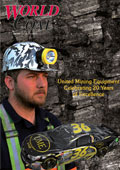Editorial comment
The latest growth figures from China make for depressing reading for anyone involved in the mining industry and further confirm that 2013 will be another difficult year. Reading the quarterly statements from the major mining companies does nothing to dispel this impression: cost reduction stands out as the current Holy Grail for mining companies. This is sure to hit equipment suppliers already under pressure: Caterpillar announced a second reduction in its 2013 earnings forecast as Q1 revenues dropped 45%, following a similarly dramatic fall in Q4 of last year. Most of this came from its mining business.
Register for free »
Get started now for absolutely FREE, no credit card required.
As has been much discussed in this and other media, mining chief executives have paid the price: BHP Billiton, Rio Tinto, Anglo American and Xstrata will all end the year under different management to that with which they started. In the case of the first three of these, the CEOs have paid the price for a splurge in acquisitions that has since come back to haunt them, with over US$ 20 billion in writedowns since January. But they are not the only ones counting the costs of the industry’s extravagance: thousands of ordinary employees have been laid off across the mining sector and more “restructuring” is promised as both mining companies and equipment suppliers try to protect their bottom line. As Anthon Fensom notes in this month’s regional report on the Australian coal industry, the Australian Coal Association estimates that its members have shed some 9000 jobs over the past year. Xstrata alone has reduced its Australian workforce by around 700 jobs and closed its Brisbane office.
Equipment suppliers have been similarly hit: Sandvik and Caterpillar have or will shed some 3000 jobs between them as they struggle to cope with the fall in demand for their machines.
While perhaps an inevitable response to the downturn, cutting too many jobs runs the risk of losing the talent that the industry will need when things begin to pick up again. As many a mining chief executive is wont to point out, the long-term fundamentals of demand are still sound. The industry must therefore be careful to avoid the mistakes of previous cycles that have led to a workforce polarised between baby-boomers approaching retirement and young entrants into the industry – with a dearth in mid-career professionals: a situation that severely hampered the industry (and saw salaries skyrocket) during the recent boom years.
This situation is not going away and unless thoughtfully addressed will return to bite the industry at the next upturn. Simply put, a mining company’s human resources policy during the current dip will effect how strongly it can bounce back. As Julian Dolby and Steve Dyson, Deloitte Touche Tohmatsu, write in this issue: “to break with the traditional boom-and-bust mentality and deliver the greater stability that sustainable productivity gains demand, mining organisations need to strengthen engagement and retention. Human resource teams need to take a long-term approach to capability development […]”
This may not be traditional thinking in an industry that often still maintains its “boom-and-bust mentality”. But as the new CEOs take up their responsibilities, they would do well to consider their human resources as much as their natural resources.


